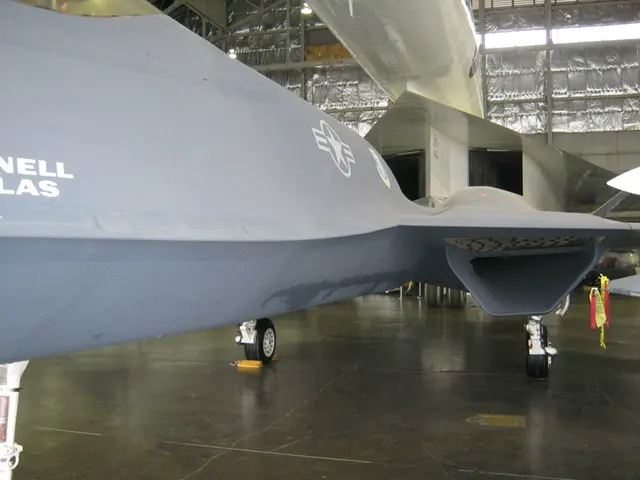astonishing assault on Russian air bases from Ukrainian drones
Ukraine's Daring, Successful Strike on Russian Airfields:
When you think audacious, you think of Ukraine's recent drone attack on Russian airfields. This wasn't just brazen, it was brilliantly planned and flawlessly executed. Here's the skinny on how they did it.
Ukraine went for the jugular, taking out military aircraft that Moscow has been using to pound Ukrainian civilians with near-daily aerial attacks. The Ukrainian military claimed 41 Russian aircraft were hit, including strategic bombers and surveillance planes, with some destroyed and others damaged.
Justin Bronk, a senior research fellow at the Royal United Services Institute in London, hailed the attack as "a stunning success for Ukraine's special services." If even half the total claim of 41 aircraft damaged/destroyed is confirmed, it could significantly impact the Russian Long Range Aviation force's ability to keep up its regular large-scale cruise missile attacks on Ukrainian cities and infrastructure.
Let's dive in and find out how the attack unfolded:
Striking from Within Russia:
The attacks targeted four airfields deep inside Russia, with the farthest one, the Belaya base in Irkutsk region, some 4,500 kilometers (2,800 miles) from Ukraine's border with Russia. The other targets included the Olenya base near Murmansk in the Arctic Circle, more than 2,000 kilometers (1,200 miles) from Ukraine; the Diaghilev airbase in Ryazan Oblast, some 520 kilometers (320 miles) from Ukraine; and the Ivanovo air base, which is a base for Russian military transport aircraft, some 800 kilometers (500 miles) from the border.
A visual shared by the SBU, Ukraine's security agency, also showed another base in the eastern Amur region as a target. It's unclear whether an attack on this base failed or was aborted. These huge distances from the border likely made Russia complacent about protecting these sites.
In fact, Moscow likely believed that the distance itself would keep the aircraft safe from Ukrainian attacks. Russia maintains air superiority over Ukraine, and while Kyiv's allies have supplied Ukraine with long-range missile systems, neither has the range to strike this deep inside Russia. However, Ukraine has been using drones against targets inside Russia, including in Moscow, but these slow-moving drones are relatively easy for Russian air defenses to strike down.
This is where the audacity of the attack really came into play: rather than trying to fly the drones all the way from the border, Ukraine managed to smuggle them right next to the sites it wanted to target and launched them from there.
Insufficient Russian Defenses:
Russia's radar and air defenses at these bases were not prepared for such a low-altitude and sudden attack. The only effective way to stop an attack like this is with heavy machine guns. However, these were either not available or not deployed quickly enough at the air bases targeted by Ukraine on Sunday—likely because Russia simply didn't foresee this type of attack.
Ukraine managed to verify and geolocate photos and videos from the scenes, confirming their locations near the bases. Russia's Defense Ministry confirmed in a statement that the attacks, which it called "terror attacks," were launched from the vicinity of the airfields.
Ukraine's President Volodymyr Zelensky said 117 drones were used in the operation. According to the SBU, the drones were smuggled into Russia by its operatives. At some point, likely while already in Russia, the drones were then hidden inside mobile wooden sheds.
Photos obtained by our company show the drones tucked just under the shed's metal roofs, slotted in insulation cavities. These wooden cabins were then placed on trucks and driven to locations near the bases. Ukraine did not reveal how exactly it managed to get the vehicles into the vicinity of high-profile military targets without detection, but reports in Russian media suggested it was relatively simple.
The Audacity of the Attack:
In an interview with BBC, a Ukrainian drone development program senior source revealed that the pilots who flew the drones were probably nowhere near the locations from which they were launched. "They would have likely set up an internet hub allowing the pilots to control them remotely, each rapidly deploying each FPV (first person view drones), hitting each target one by one."
The source added that the communication hub could be "a simple Russian cell phone" which is harder to track than other systems, such as Starlink that is widely used in Ukraine. A source briefed on the matter confirmed the attack was carried out via Russian telecommunications networks.
Once the trucks were in place and the drones ready to go, the cabin roofs opened, and the drones flew towards their targets.
'Brilliant Operation':
The operation was apparently in the making for one and a half years, and President Zelensky praised the security services for a "brilliant" operation. Russian officials have downplayed the attack, stating that strikes were repelled in the Ivanovo, Ryazan, and Amur regions, but that "several pieces of aircraft" caught fire after attacks in the Murmansk and Irkutsk regions. It added that the fires had since been extinguished.
Despite Russian authorities downplaying the attack, several high-profile Russian military bloggers have been vocal in their criticism. Rybar, a high-profile Russian military blog, stated that the attack caused a "tragic loss for the entire Russian air fleet" and was a result of "criminal negligence."
The SBU stated that the strikes caused an estimated $7 billion in damages and hit 34% of Russia's strategic cruise missile carriers at its main air bases—a claim our company cannot independently verify. Ukraine said it destroyed several TU-95 and Tu-22M3 strategic bombers and one of Russia's few remaining A-50 surveillance planes.
Air force spokesman Yuriy Ihnat told Ukrainska Pravda that while some of the aircraft were completely destroyed, others may be repairable—although they would likely be out of action for a long time. A source briefed on the matter revealed that 27 Tu-95, four Tu-160, two Tu-22M3, and "probably" an A-50 were hit.
The Tu-22M3 is Russia's long-range missile strike platform that can perform stand-off attacks, launching missiles from Russian airspace well behind the front lines to stay out of range of Ukrainian anti-aircraft fire. Russia had 55 Tu-22M3 jets and 57 Tu-95s in its fleet at the beginning of the year, according to the "Military Balance 2025" report from the International Institute for Strategic Studies think tank.
Ukraine's daring, successful strike demonstrates the power of innovation, strategic planning, and a little bit of cheekiness in warfare. Time will tell if this sets a new precedent for guerrilla warfare in the 21st century.
- Ukraine's recent success in infiltrating and attacking Russian airfields, specifically the Belaya base in Irkutsk region, Olenya base, Diaghilev airbase, and Ivanovo air base, showcases the profound impact of innovation and audacity on the war-and-conflicts scene.
- The finance industry may experience a significant shift due to the aftermath of this strategic strike, as the possible $7 billion in damages caused by the Ukrainian attack on Russia's strategic cruise missile carriers could have a substantial impact on Russia's budget for future military investments.
- The political landscape could also be affected as this daring, successful strike on Russian airfields demonstrates a new level of ingenuity and tactical prowess in the aerospace sector, potentially influencing politics and foreign policy discussions related to war-and-conflicts and general-news among the international community.






